How to Remove and Install a Bathroom Faucet
Two for one! In this article, you’ll get two tutorials: how to remove a bathroom faucet and how to install a bathroom faucet! Because they go hand when doing any sort of bathroom remodeling or upgrade.
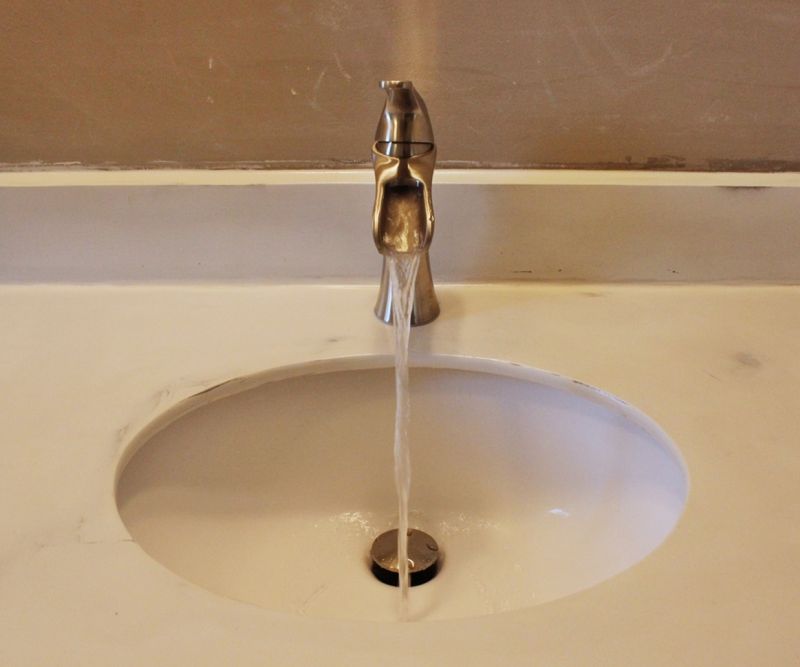
While this tutorial shows a different strategy for what happens with the faucet on top of the countertop (check out this article on creating a faux marble countertop for details), the method of hooking up the water for the plumbing will be the same. Let’s get started.
How to Remove a Bathroom Faucet

(You can also check out this tutorial for removing and installing a kitchen sink faucet.)
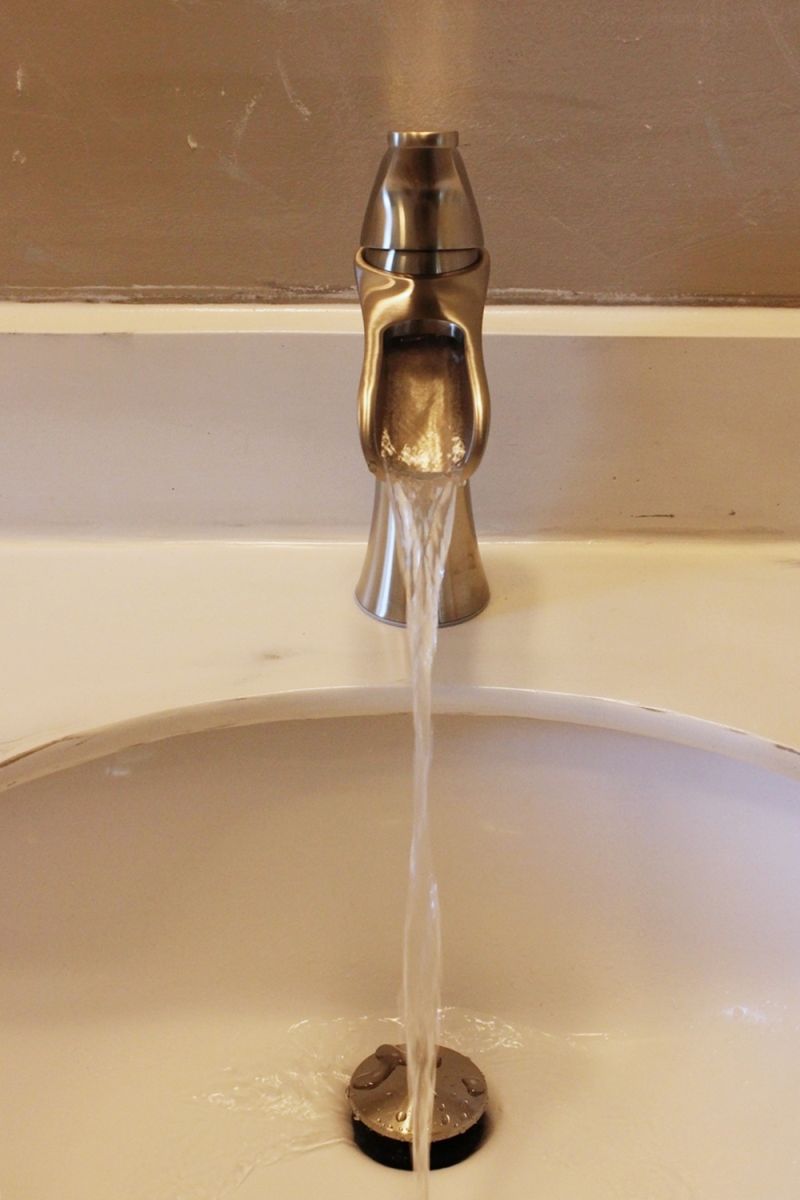
Step One: Turn off water before you remove the bathroom faucet
Start by turning off the water under your bathroom sink. Have a bucket handy, because you will have some water leak out when you go to unhook the hoses.

Turn off both the hot and the cold water valves. Also, while you’re down here, unhook the sink stopper.

Step Two: Remove stopper from the bathroom faucet
Before removing the bathroom faucet, you have to pull the sink stopper out so it’s out of your way. Chances are, your space is limited underneath that small bathroom sink, so any opportunity you have to remove something to clear out some space is an opportunity you should take.
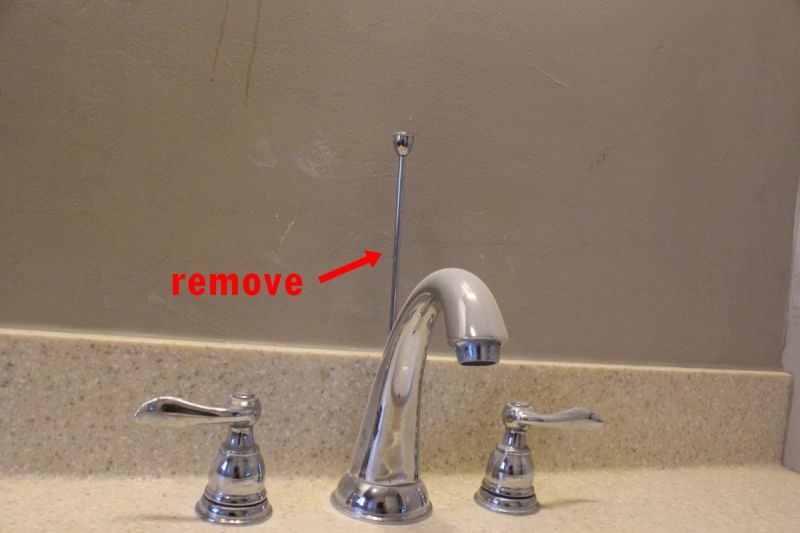
Step Three: Drain any water from bathroom faucet
Turn on the faucet handles to let any residual water drain into the sink.

Step Four: Unscrew fittings
Use a crescent wrench to unscrew the hoses. Careful not to strip them or they become difficult to remove from the bathroom faucet.

If you have a plastic connector, unsnap the plastic guard.

Then squeeze the two plastic tabs on the sides, and pull the connector off.

Securing each component of the faucet (the handles and the faucet itself) will be a nut of some sort, screwed into place. Use a screwdriver to loosen these screws.

Then twist the brass nut counterclockwise to unscrew it as well.

Twist it until it comes all the way off. You’ll notice a rubber O-ring. This should be removed as well.

Pull off all components that were holding the handle into place from the underside of the countertop. Repeat for the other handle.

Use your crescent wrench to unscrew the large nut that secures the faucet (and accompanying plate) into place.
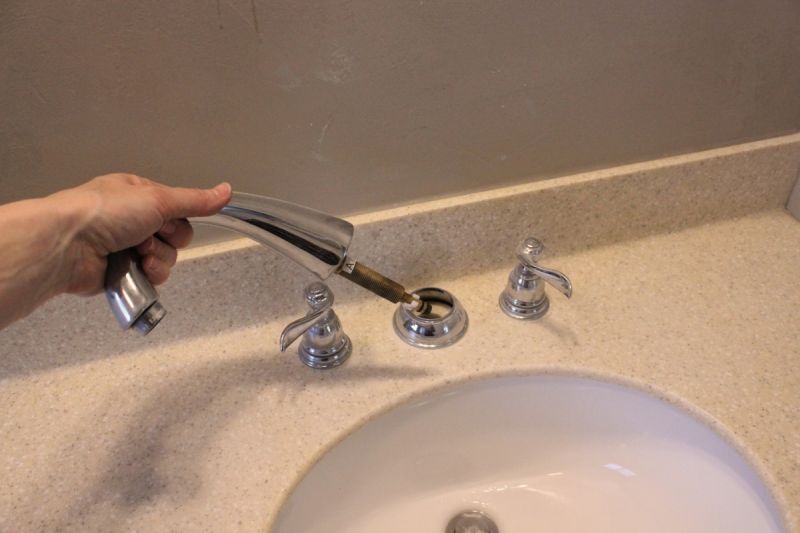
Step Four: Remove bathroom faucet
With all of the under-counter components loosened and removed, you can now remove all your faucet parts. Pull out the faucet.

Remove the handles of the bathroom faucet.

Pull off anything else from the countertop so that all you are left with are your exposed bathroom faucet holes. Nicely done! Make any changes to your countertop you wish (here’s an idea for faux marble with concrete, as well as a transition from a three-hole faucet setup to a single hole), then get ready to move onto your new faucet installation.
How to Install a Bathroom Faucet

Step One: Prep new faucet
The faucet we’ll be installing today is called a Jaida. It’s a single-hole faucet with a pop-up drain. Let’s see hwo to install the bathroom faucet!

Remove the bathroom faucet from the box. From the mounting bolt, unscrew the nut and remove the mounting plate.

Step Two: Check pipes before installing the bathroom faucet
At this point, it’s a good idea to identify which of the copper pipes is for hot and which is for cold. These should be labeled. In this case, the longer pipe is hot.

Step Three: Attach O ring under bathroom faucet
Grab your plumber’s putty. This will go on the rubber O-ring to seal the space between the countertop and the rubber ring. (On top of the rubber ring is the faucet itself.)

Take little bits of plumber’s putty at a time and fill the groove on the bottom of the rubber seal.

Step Four: Put in place before installing the bathroom faucet
Place the seal and faucet on the countertop, threading the pipes and mounting bolt down through the countertop hole.

Try not to move the rubber seal much after placing it, to ensure that the plumber’s putty stays put. Do a preemptive straightening of the faucet, although you’ll need to come back to it a little later in the process to make sure it’s completely straight.

Step Five: Attach fittings to install the bathroom faucet
On the underside of the countertop, replace the mounting plate (bumps toward the countertop so as to improve “grip”) and nut. Don’t crank down too hard on the nut at this point, although the faucet should be able to stand up securely on its own after tightening the nut underneath.

Take one of the adapters and one of the pins. These will attach to the end of either the hot or cold pipe (coming out of the faucet), allowing you to later connect the house’s hot or cold water source to the faucet.

Pop the adapter onto the pipe, threaded side down. Position the pin to hold it securely in place. Repeat for the other adapter, pin, and faucet pipe.

Attach Teflon tape to the threaded end of one of the adapters. This helps to solidify the seal, when you go to connect the water, to prevent leaking. Teflon tape is vital to installing a bathroom faucet!

Step Six: Attach hoses to bathroom faucet
Using a plumbing hose extension (which should be already attached to your water sources from when you removed your faucet originally), connect the appropriate water source to the Teflon taped adapter. Hot water generally comes from the left, cold water from the right.

Repeat for the other adapter and hose: Teflon tape, adapter, hose. Although the water should still be off at this point, you’re all hooked up.

Step Seven: Adding the Drain when Installing the Bathroom Faucet
Because the Jaida faucet comes with a pop-up drain, we’ll need to remove the old drain in order to install it. Begin by removing the drain lever under the sink.

Then loosen the nut that connects the drain pipe to the sink itself. This will probably require a wrench.

Unscrew the nut enough so that you can push upward on the drain.

Have a helper grab a pair of pliers. While one person gently pushes the drain pipe upward, the other person will grab the drain ring from in the sink and pull it out.

Remove the drain ring completely. We never said installing a bathroom faucet would be glamorous.

Unscrew all the pieces under the sink from the drain pipe down to the P-trap (but don’t remove the P-trap). This will likely include the drain pipe and then another black plastic coupler pipe with two black rings, one on top and one on bottom, and plastic seals.

You can get rid of the drain pipe, but you’ll want to keep the black coupler pipe (assuming it’s still in good shape). Wash all components, then replace it back onto the P-trap.

Thoroughly clean the sink drain hole.

Step Eight: Place new drain
One of the last steps to installing a bathroom faucet. Place the new pop-up drain into the sink drain hole. Straighten out any words or logos on the drain, if that sort of thing is important to you.

Before you push the drain all the way down onto the black coupler pipe, you’ll need to thread the new drain pipe down through new plastic seal and “nut,” in that order.

While one person works the new seal up toward the bottom of the sink, the other person should hold the drain in place above in the sink.

Screw on the new “nut.” Again, someone should be holding the drain in place, particularly if you’re trying to keep any words or logos straight.
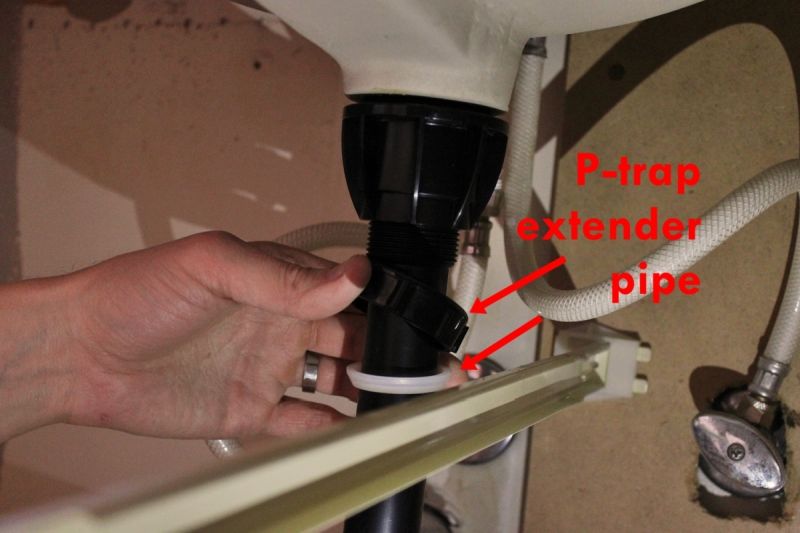
Affix the black coupler pipe (also could be thought of as the P-trap extender pipe) to the new drain pipe.

It’s all coming together!

Step Nine: Double check the drain in your new bathroom faucet
When everything is tightened, check out the new pop-up feature of your drain. Don’t be alarmed if, in the plug position, the metal doesn’t touch the sink.

The plugging mechanism is actually underneath the metal drain plate.

Step Ten: Final touches on installing the bathroom faucet
With the drain in place and looking awesome, it’s time to make final adjustments to the faucet itself. One person should hold it perfectly straight from up above…

…while the other person tightens the faucet nut a little more from under the sink.

Use a wrench for these final tightening steps. Tighten the water connections.

Step Eleven: Test for leaks
When installing a new bathroom faucet, the last thing you want is leaks. Turn your water lines back on, and try out your new sink. Hang out under the sink for a while to make sure there are no leaks; if you notice any water, turn the water off and tighten up the leakage.

Congratulations! You’ve just upgraded your bathroom vanity faucet, and it functions well and looks amazing.
Note: The author is an experienced, although not professional, DIYer. Neither the author nor Homedit is responsible for any injury or damage that may be a result of following this tutorial.
